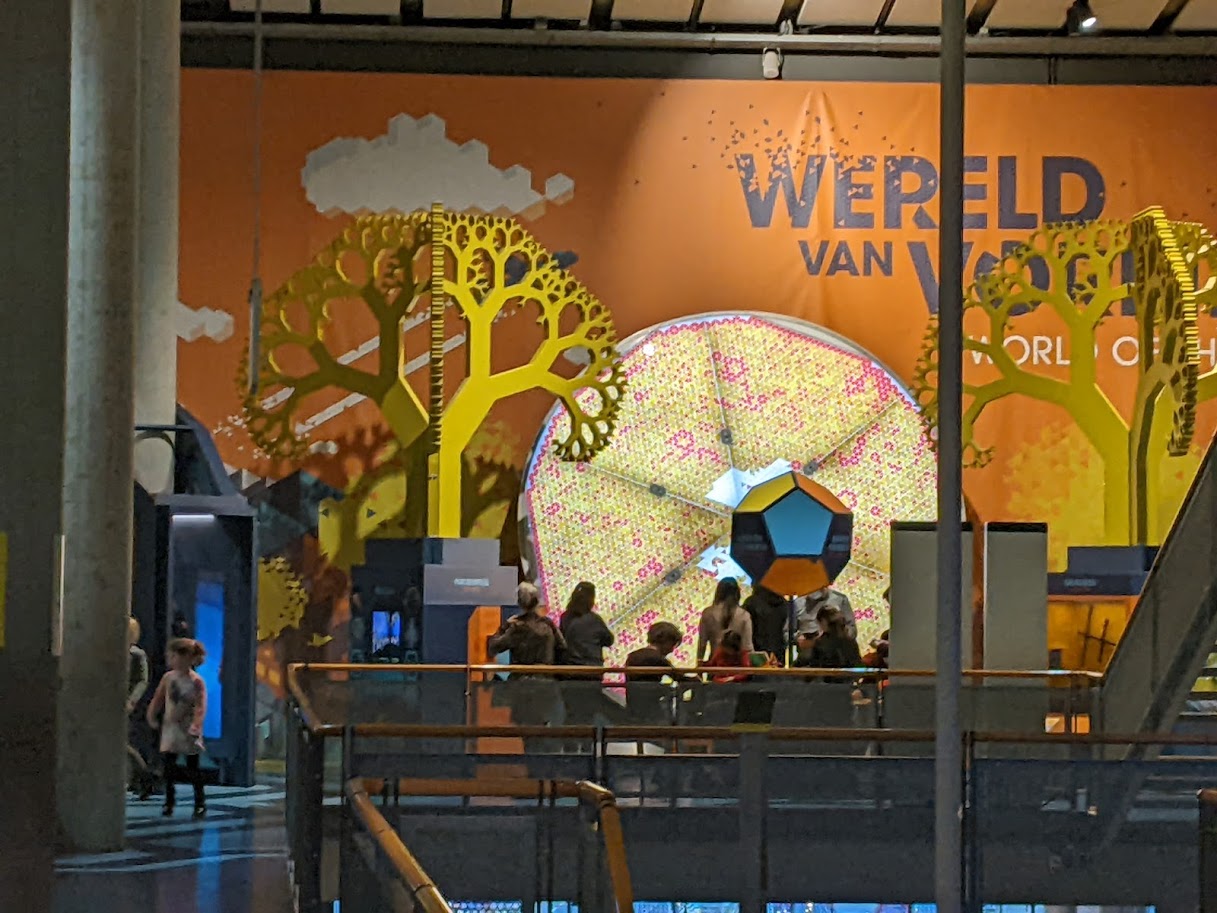I mentioned in my last post that J and I were once eleven together. We were best friends, back in the 1980s, when we met by riding the same bus home from school and spent the entire trip staring at each other, wondering whom that interesting-looking kid was. Eventually, I held the door for her on our way off the bus, and that broke the ice and let us start talking. Aside from a brief period in our early twenties when we lost track of each other, we haven’t stopped since.
It’s great to be with friends from that long ago, because you turn into kids again as soon as you’re together. Today, the two of us went off to the Nemo Science Museum, to be eleven again and play with all the cool exhibits. It was a lot of fun.
The Nemo Science Museum in Amsterdam is shaped like a ship — something the architect claimed was coincidence, but given the tendency for everything in the Netherlands to have something to do with boats, I kind of have to wonder. At any rate, we’d seen it yesterday from the canal boat tour, and it sparked my interest. So we got our Covid tests this morning — a requirement for entry to any museum or other tourism site; they’re free from the Dutch government but only last 24 hours, so you’ve got to either fit your museums in quickly or do a lot of repeated testing — and then went out this afternoon, well wrapped against the cold and the damp, to explore the science museum. Because we could.
The first thing you see on entering the museum (other than a polite guard who’s checking your Covid test results) is a set of spinning glass bulbs dangling above the entry line. They’re the perfect lights for a science museum, especially since they’re purposely not quite perfect in form. Each one is a bubble of what appears to be blown glass but bigger, and they spin on their cords, with each one at a slightly different rhythm and speed. I was fascinated with them, and kept staring up at them while we waited our turn to enter. If they mesmerized actual children as effectively as they mesmerized me, they would be worth a great deal to a museum which has to ask families with small kids to wait in line for a while before it can process their tickets and let them in!! Finally, we were allowed loose, and took the elevator to the top floor to work our way down.

On the fifth floor, there’s not a great deal other than the restaurant and an outdoor roof deck with some sculpture elements that are supposed to let you play with energy. (Also to let you play, and work off energy — the roof was set up to let little kids run around more than they could indoors.) Some of the sculptures seemed to work via solar power, which is doubtless why they’re kept on the roof; the problem is that there was no visible sun on a February day in Amsterdam, making them fairly ineffective. Others worked by rotation or movement, and those were more successful. The best feature of the roof garden, though, was its view over the city, especially the nearby harbor where old ships were kept. That wasn’t technically part of the museum exhibit, but we enjoyed it nonetheless.

On the fourth floor, things were much more promising. A huge complex of stations about the human body and brain let us test ourselves, play with exhibits, and generally run around exploring elements ranging from the origins of the hominid family to how exactly an individual face will age (based on factors ranging from how much time they spend in the sun to whether they smoke or eat junk food).
The most interesting of them for me was a device which claimed to test your ability to remember colors. First it asked your group — however many of you there were — to concentrate together on a color it showed you. Then, one by one, you walked down a long tunnel and emerged at the other side. When you reassembled at the far end, it showed you a few different colors and asked you to point out the one you’d seen before.
I watched a few people go through this test before J and I tried it, and I admit I was a little confused by why they bothered to have you walk down the tunnel. I guessed it might be in order to give you some form of distraction between seeing the color and having to recall it later. Not so: when you got to the far end and identified your color, the test admitted that it really didn’t have anything to do with memory for color at all!! That was the distraction, to keep you thinking about something other than the walk down the tunnel. What they really wanted to know was whether or not you could identify the members of your party by the way they walked, after the photographs were stripped out and only a stick figure left on the screen to represent the exact specifics of movement style for each of you, as you’d walked down the tunnel a moment ago.
I’ve seen psych studies done, when I was in college, where the real topic has nothing to do with what it looks like they’re testing. They’ve always interested me, but I’ve never been as thoroughly taken in by any as I was by this one. You don’t expect exhibits in a museum to fool you that way, somehow! At least I didn’t. (And no, I did not successfully identify which of us was which by the way we walked. I had a fifty percent chance on pure luck and I blew it anyway.)
There was a LOT of stuff in the Humania exhibit. There was a “hugging machine” you could experience, which looked (and felt) a bit like going through a friendly clothes wringer; and there were exhibits on how seeing images of other people affects the way we think about ourselves. They didn’t shy away from difficult topics, either. They had a whole section about human sexuality that would never have been allowed in an American museum that was aimed primarily at children, and another on aging and death. I thought they handled both very well — tactfully but without apology for explaining the facts clearly and accurately. The United States has become, in my view, very much too inclined to limit what is said in anything aimed at children, in case it might offend their parents. If the information is true, I believe it should be presented without apology… and then, if parents don’t want to bring their children to that exhibit, they don’t have to. But that’s the part they should get to decide — not whether the museums tell the facts at all or not, but whether they want to bring their kids to that museum, or that exhibit.
The third floor was their section on technology. Some of it — for example, their space exploration exhibit — were what you’d find in any other science museum, but I was fascinated by the multiple exhibits centered on the Netherlands and its ongoing battle with water. The Netherlands, of course, lie below sea level, meaning that they survive by a complex arrangement of defenses which protect them from flooding. With climate change slowly causing the sea level to rise, these defenses have only become more difficult in recent decades. So it’s not really surprising, I suppose, that water played such an enormous part in the exhibit about energy and movement; but it’s definitely very Dutch. It caught my attention even more, because I was coming from Africa, where water has an entirely different set of roles in daily life. In some places, there isn’t enough of it at all; in others, it exists but isn’t always safe; but the one thing they pretty much never have to worry about in any area in Africa where I visited was having too much water and needing to keep it out so it didn’t flood the whole place!! Definitely a mental context-shift for me.

The technological floor also had a complicated multi-player game about manufacturing and transporting goods throughout the world. The Netherlands have also been a mercantile country since time out of mind; it made its wealth with its global shipping fleet in the 17th century. So it’s not surprising that it has a focus on getting things from point A to point B, when it looks at the technologies of economics. There were a whole lot of little balls that had to be run through a complicated “factory” and then “shipped” out of it to end up, finally, in the correct people’s mailboxes. It looked like a lot of fun but every station on that game was occupied — the Dutch kids clearly found it fun also, and many of them appeared to be fiendishly good at it! So I didn’t get to play, but I did watch for a while, and was very impressed.
Finally, the second floor was simply called “Phenomena,” and it focused on basic principles of physics. How light and sound moved, what Newton’s laws did in practice; that kind of thing. It had simpler exhibits but more of them, little stations where you could guess what would happen if you did something, and then try it and find out. We ran around trying them, among the three and four year olds (this floor was mostly for the youngest kids) and having a grand time.
This floor also included the museum’s Rube Goldberg machine. I’m convinced that every science and industry museum needs to have a Rube Goldberg machine, the same way every herd of zebras needs to have a wildebeest. My favorite has always been at the Franklin Institute in Philadelphia — a massive thing almost the size of the two-story room that it occupies. You fire a pinball into the machine at one end with a plunger, and it takes about half an hour to drop into a cup at the other, after going through every corner of that vast, complex piece of machinery first. This one was a far cry from that; it was much simpler in the first place, and in the second, it was broken when we visited, so we couldn’t even see it working. I was disappointed. Rube Goldberg machines are a favorite of mine.

Finally, that second floor had something I’ve never seen in any other science museum: an exhibit on science itself. There was a section about what exactly the scientific method is; how you tell if something is science or opinion; how scientific research is done, and how we can know that we know something, with at least some degree of reliability. It was right next to a room where they did occasional actual research with participants from among the museum guests — usually testing the impact of new exhibits, from what I could tell, though it was closed at the moment.

I thought the exhibit about scientific method might have been my favorite in the whole place — not because it was so much fun, it was pretty standard; but because it’s such a vital topic to teach, and so few science museums actually do it.
Tomorrow, we get out of town! Specifically, we take the train to Leiden, a small city about 45 minutes from Amsterdam, containing the University of Leiden with its great archaeology department, and the corresponding National Museum of Antiquities. Stay tuned!


Leave a Reply